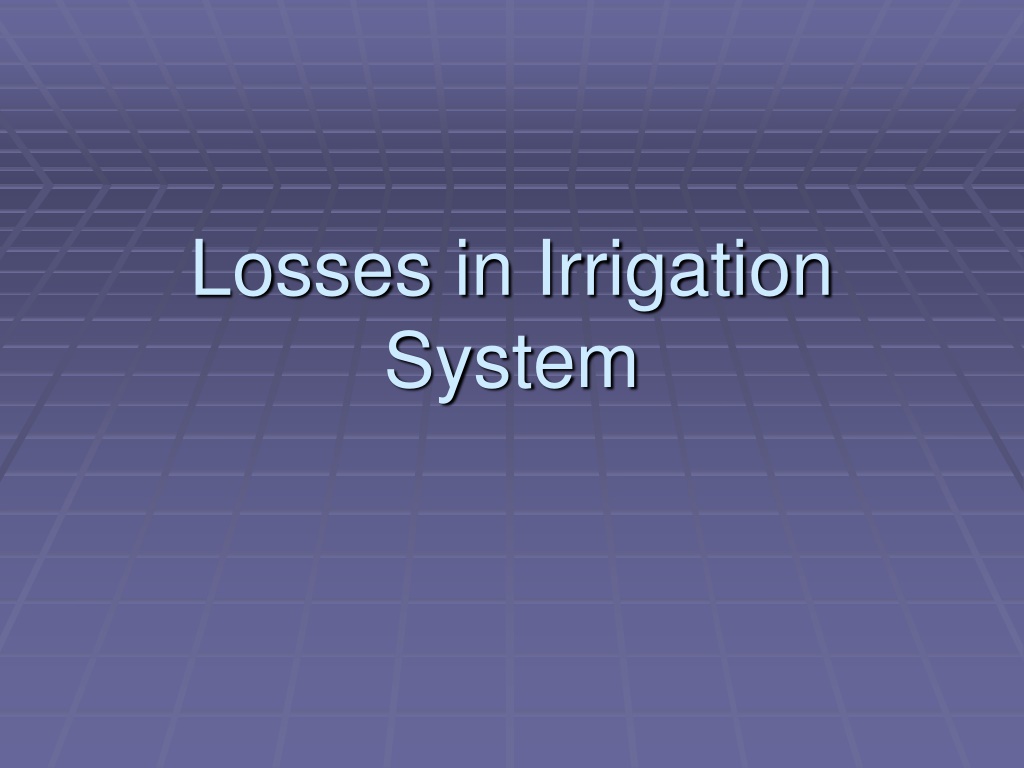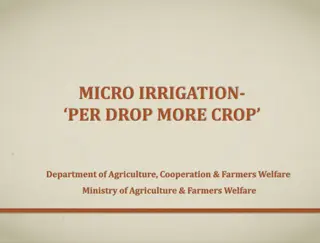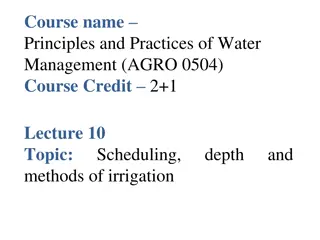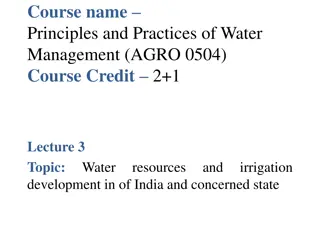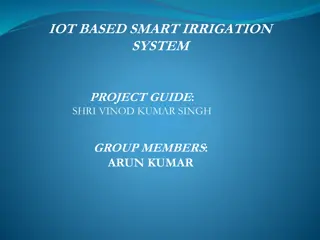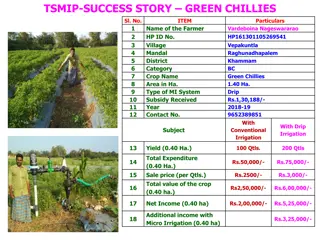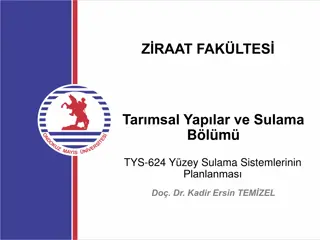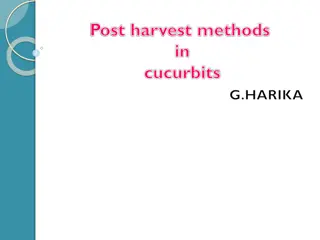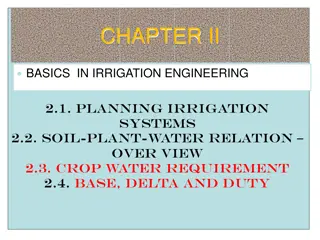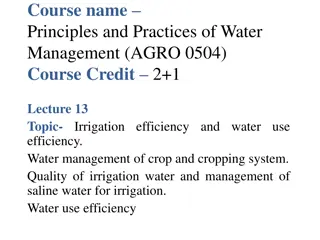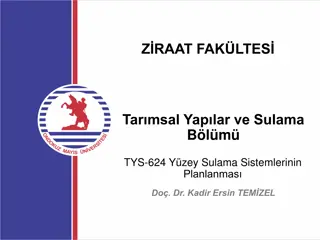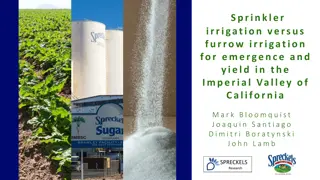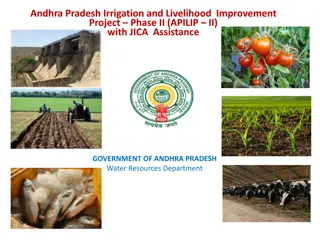Understanding Losses in Irrigation Systems: Measurement Methods and Techniques
Losses in irrigation systems, including seepage and evaporation, are major concerns impacting water conservation. This article discusses historical estimates of losses, types of losses (seepage and evaporation), methods used to measure losses (direct and indirect), and detailed information on seepage meters. Various empirical formulae, lining of canals, and B/C analysis are also explored to enhance understanding of loss measurements in irrigation systems.
Download Presentation

Please find below an Image/Link to download the presentation.
The content on the website is provided AS IS for your information and personal use only. It may not be sold, licensed, or shared on other websites without obtaining consent from the author. Download presentation by click this link. If you encounter any issues during the download, it is possible that the publisher has removed the file from their server.
E N D
Presentation Transcript
Losses in Irrigation System
Content Losses How to measure Historical Estimates of losses measurements Some empirical formulae Lining of canals B/C analysis
Types of losses Seepage Major reason of water lost Vary from 2 to 50% Evaporation Depend on climatic perimeters and surface area 2-3% of canal diversions Max. in Kharif, and is limited to 7% of flow.
Methods used to measure Seepage Direct Methods Ponded Test method Inflow outflow method Seepage meter Indirect Methods Steady state method Canal closure method
Direct Methods Ponded method Canal is filled with water. Inflow and outflow is stopped Losses measured through change in water level in canal at regular interval (e.g. daily) Have to close the canal, and not recommended for Main Canals Inflow Outflow Method (frequently used) Water budgeting is done Flows are measured at upstream, downstream end and diversions Seepage = Inflows Outflows Relatively Quick, Simple, but depends on accuracy of discharge measurement (Notch Coefficient? Current Meter?)
Ref: Inflow outflow method
Seepage Meters It has been used for seepage measurement in Canals, Rivers, Coral Reefs, Marine Environment The basic concept of the seepage meter is to cover and isolate part of the sediment-water interface (the bed of channel) with a chamber open at the base and measure the change in the volume of water contained in a bag attached to the chamber over a measured time interval. The classic design of Lee (1977) consists of a 15-cm end section of a 55-gallon (~200L) drum, which is inserted into the sediment. A stopper with a tube is inserted into a hole in the top of the drum and a plastic bag is attached to the tube with rubber bands. The time when the bag is connected and when it is subsequently disconnected is recorded, as well as the change in the volume of water in the bag. The seepage flux (Q/A) is calculated as: Q/A=(Vf-Vo) / (t A), where Vf & Vo are final and initial volume of water in bag, respectively. A is bottom area, t is interval.
Methods of loss measurement Indirect: Steady State Knowledge of soil permeability and water table level is required Flow net is drawn based on water table around canal Seepage losses are calculated, using Darcy Formulae Q = K i A Q = Seepage flow K = Permeability i = Head Loss Gradient = HL/L A = Area of flow Q/A = discharge velocity (not actual velocity, that depends on capillary area) (for further detail on flownet: GARG page 1058-1059, )
Indirect method (Steady state) Canal Section Flow lines H Water Table Percolation: When seepage reaches to water table (H is effective) Absorption: When saturation line due to seepage is above the Water Table (Full H is not effective, rather head upto saturation line+Capillary head is active)
Indirect method Canal Closure Method: Continuous observation of Water table profile is done during canal level fluctuations (before, during and after canal closure) near a canal. Seepage is computed by simple graphical means using observed water table profile with time. This method was performed on 44 canals in Sukkur and Kotri command canals during annual closure of Dec/Jan1964, April/May 1964. Difficult and not much reliable.
Factors affecting Seepage Type of seepage (Percolation or absorption) Soil permeability Condition (age) of a canal Seepage through silted canal is less than a new canal Amount of silt in canal More silt: less seepage Velocity of canal More is velocity, less will be losses Full Supply Level wrt Ground Level and Water Table X-Section and wetted perimeter Maintenance of the canal
Seepage Losses in Irrigation Canals in Pakistan Many studies to estimate the seepage losses Col Dyas (1863): First Civil Engineer: Experiments on Mainline Upper Bari Doab: To determine seepage losses. Estimated that losses are of order of 20% of Canal Head Discharges Proposed P=C (d)0.5 where C is coefficient, d is depth in ft, and P is loss in cusecs per million sq ft. of wetted perimeter. Other studies: Higham, Kennedy, Lacey, Ivens and Hulton.
Early studies Higham (1874): Bari Doab Canal 12.74% of flow of 2114 cusecs (Head reaches) 19.1% of flow of 336 cusecs for lower reach Kennedy (1881-82): Sirhind Canal (Punjab): Cold Season: Out of 100 Cusec entering the canal at head: 20 cusecs (20%) is lost in Main Canal 6 cusecs in distributaries (6% of head flow, or 7.5% of Distributaries flow) 21 cusecs in village water course (21% of head flow, or 28.4 % of flow in water course) Results of early studies (before 1920) are of wide range (4 to 20 cusecs per MSF)
Sharma (1938-40) studies S No Canal Range of Losses (Cusecs/MSF) 2.3 to 8.5 1 Upper Jhelum 2 Upper and Lower Chenab 2.5 to 9.0 3 Pauliani Distributary 1.0 to 2.5 4 Mangtanwala Branch 0.5 to 6.5 5 Biknar Main Line (Lined canal) 1.5 to 2.0 For Punjab a range of 0.5 to 9 cusecs per MSF
Irrigation Deptt Punjab Experiments For Eastern Channels: Qs=5 Q0.0625 Qa=0.0133 L Q 0.5625 L is length in thousands feet, Qs is seepage loss (cusec) per MSF of wetted perimeter, Qa is seepage loss in cusecs, and Q is channel discharge in cusecs Water and Soil Investigation Division (WASID) of WAPDA Studies: Inflow outflow method 300 independent measurements 70 were selected based on consistency Wider Variation of losses are found
Irrigation Deptt. Studies Canal Doab RD Method Seepage (Cusecs per MSF) 10.3 Reference Jhang Br Rechna 260 to 32,260 Statistical A.R. IRI 1938 Kasur Br Bari 8500 to 104400 Current meter and sounding rod by Malhotra -do- 10.5 Main Ali Br. Of Lower Chenab Canal Rechna 0 to 134, 850 Statistcial methods A.R. IRI 1940 13.7 Kasur Br Bari 8500 to 104,400 Sharp crested weir at two sections A.R. IRI 1941 4.8 to 7.5 Punjab all All doabs Analysis by Crump using 20 years data Punjab Engg Cong. Paper no 248, 1947 8 - 25
WASID (WAPDA) Studies Doab Canal Seepage (Cusecs per MSF) Seepage (Cusecs per Canal Mile) Thal Mohajir (Lined) 9.85 3.3 8.6 Rangpur 6.05 to 14.6 2.6 to 9.3 Mainline (lined) 21.7 9.9 Munda (Lined) 21.73 to 48.92 4.13 to 9.46 Piplan Dist. 8 0.66 Chaj UJC 7.9 10.9 LJC 19.18 16.73 Rechna Burala 6.3 to 22.4 2.4 to 13.1 Manawala 2.74 0.64 Bari BRB Link (Lined) 10.16 to 5.85 11.7 to 7.3
Regional plan for Northern Indus Plains (1967) Losses in Link Canals BRBD : 8 cusecs per MSF MR : 8 B-S II : 6 Q-B : 8 R Q : 8 S-M : 2 (80% lined) T-S : 8 C-J : 12 T-P : 12 Losses in Rabi are taken as 80% of Kharif Losses in Main canals are also taken as 8 cusecs/MSF
Lower Indus Report Till 1960 no study for Lower Indus 1963-64 Sir Mac Donnald and Partners Study Methods used: Direct Methods Ponded Test method (not for main canals) Inflow outflow method (Loss=Inflow-Outflow) Indirect Methods Steady state method Canal closure method
Losses in Sindh Canals Ref: (Lower Indus Report) Canal Seepage (Cusecs per MSF) 5.6 4 2.5 4.2 6.1 4.3 5.8 7.5 4.8 North West Canal Kirthar Branch Raine Dadu Johi Br. Khairpur Br. Rohri Canal Nusrat Br. Jam Br. Ref: Sindh WSIP study, 2012 by Nespak, ACE & Temelsu,2012.
CRBC Study (Siddiqu et al. 1990-92) Earthen Channel: RD 0 to RD 120+000 Concrete Lined Channel: RD 120 to RD 260 Water table varies between 3-10 ft along the channel Mainly Fine textured soils in the project (22% is coarse) Used Inflow-Outflow method Losses cusecs/MSF Unlined Channel: Weighted Average, Max., Min = 4.381, 11.01, 0.8 Lined Channel Weighted Average, Max., Min = 2.97, 6.32, 1.281
Other studies Ref: Garg SK (1999) Loss = 0.005 (B+D)2/3 (Used in UP India) Loss in cumecs per km length B is width and D is depth of channel in meter Loss = 1.9 Q 1/6 (Used in Indian Punjab) Loss in cumecs per million sq. meter of wetted perimeter, Q is flow in cumecs
Lining of Canals (Ref: Garg, 1999) To stabilize the earthen surface of the canal using: Concrete or bricks, tiles or asphalt, Geomembrane. Can reduces losses upto 90% of original losses Lined canal normally costs 2-2.5 times that of unlined canal Benefit cost analysis should be carried out before decision of lining
Benefits of Lining Seepage control Can be a single factor for decision Result in more water availability which will lead to Small storage reservoirs, Small sections of channel for same command area
Seepage through various surfaces (Garg, 1999) S No Type of lining Initial seepage (Cumecs per MSM) 7.4 Stabilized Seepage (Cumecs per MSM) after lining or stabilizing 1 Unlined Channel 3.4 2 30x15x5 cm tiles using 1:3 c/s mortar 0.17 0.009 3 PCC 1:3:6, 10 cm, 0.13 0.007 4 10cm Lime concrete 1(cement):5(lime):12(Surkh i): 24(Brick ballast) 0.4 0.13 In general For Lined Channels: Qs = 1.25 Q0.056 where Qs =Absorption loss per million Sq.ft
Benefits of Lining Prevention of Water Logging and Salinity 1 Millions acre of land were being wasted due to Water Logging and Salinity (in 1960 s) Increase in Channel Capacity Due to reduced n value Increase in command Area Mild slopes (without sedimentation) will result in higher levels and thus larger command Reduction in Maintenance Cost Less silt removal (Bhul Safai), less weeds removal and less repairs Reduced Breaches (flooding)
Financial Justification Annual Benefits: =mC1+pC2 Where: Annual Cost If C= Y= r = Annual Cost = cost per year + interest per year = C/Y + 0.5 r C (considering the time value of money) Annual Benefit/Annual Cost should be at least 1 for a decision of installing Lining m = Water saved by lining (cumecs) p = Fraction of maintenance cost saved due to lining C1= Cost (or revenue) of Water per Cumec (Rs/cumec) C2= Cost of Maintenance of unlined channel (Rs) Capital Cost on Lining (Rs) Life of Lining (years) Interest Rate (%)
Example 5.1 (Garg 1999) Current Seepage Loss = 3.3 cumecs/MSM Seepage loss with lining = 0.008 Cumec/ MSM Lining with 10 cm (PCC) Cost of lining = Rs 30,000 / 10 sq m Annual Revenue from crop = Rs 50 million/cumecs Q = 83.5 cumecs Sectional Area= 108 m2 Wetted perimeter (unlined channel) = 44.5 m Wetted perimeter (lined channel) = 44 m Annual Cost of maintenance of unlined channel = Rs 2000 / 10 sq m p = 0.4 (saving in maintenance cost) r = 10% Assume suitable values if missing
